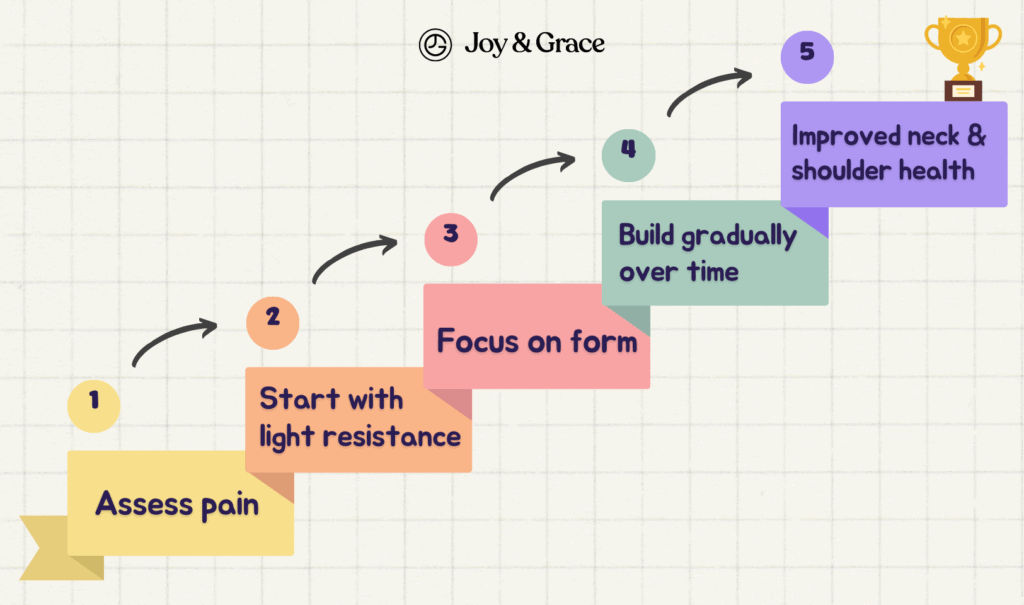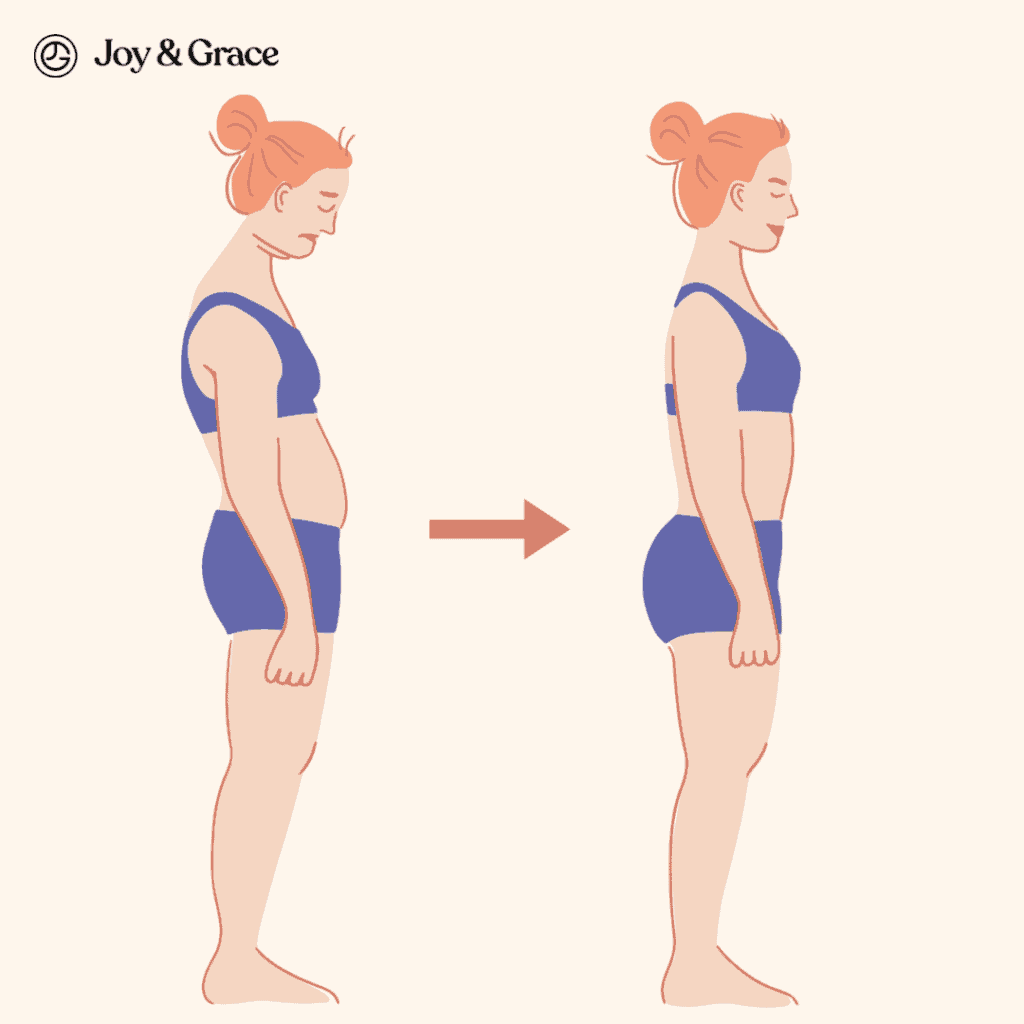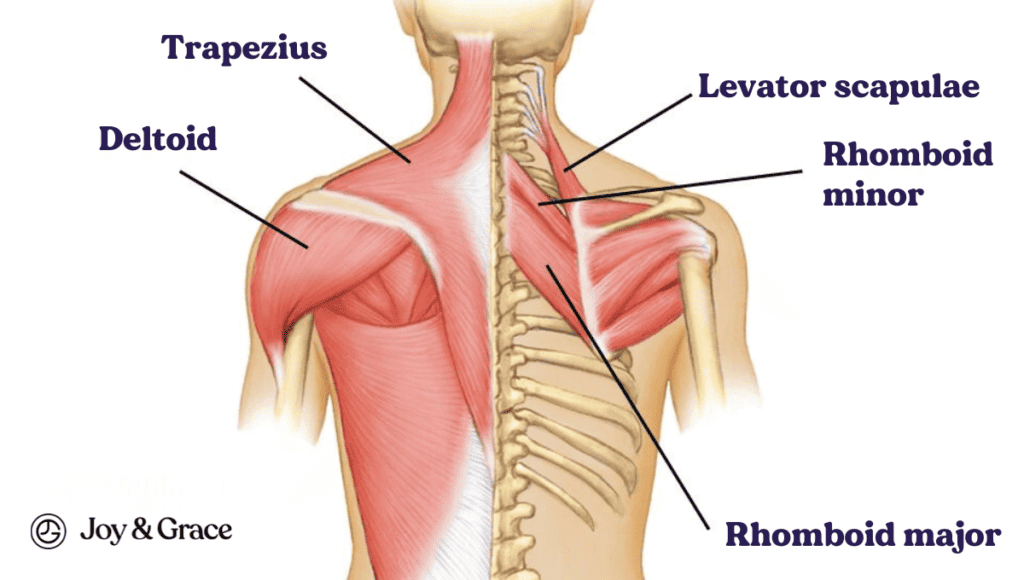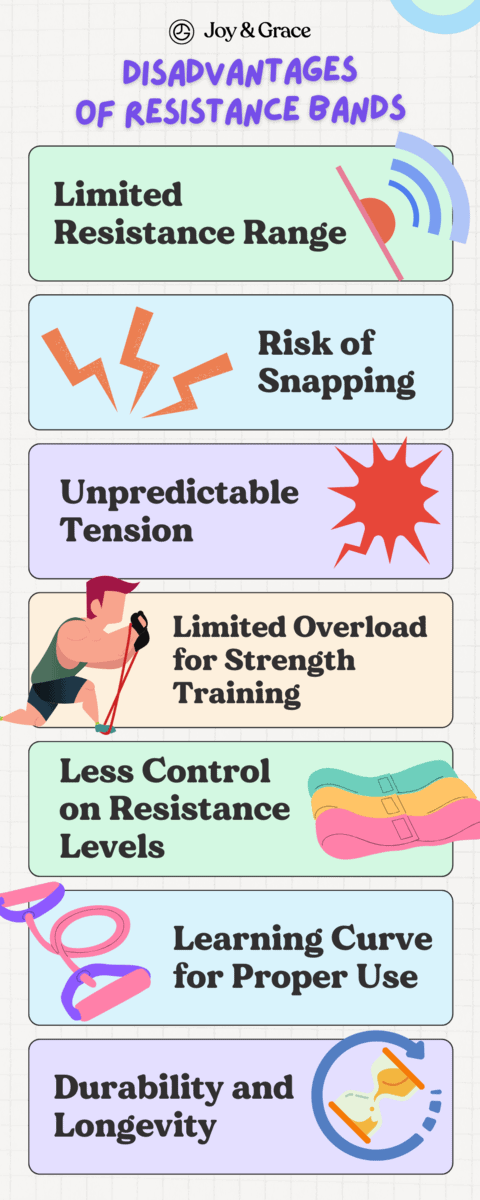We know how it feels. That dull, throbbing pain in your neck and shoulders from being hunched over your computer all day. It can make concentrating hard, ruin your mood, and keep you from sleeping.
We believe that no one should be in constant pain. So, what if we told you there was a simple, cheap fix?
Enter the magic of resistance band exercises. Let’s look at resistance band exercises for neck and shoulder pain so you can get rid of the pain and have a better, more productive day. Trust us. Your neck and shoulders will thank you.
Are Resistance Bands Good for Neck Pain?

Yes, resistance bands can be extremely beneficial for tackling neck pain. Experts in fitness and wellness strongly advocate resistance training as opposed to just any exercise. And resistance bands may be as good as traditional weights.
According to one study, isometric neck exercises with resistance bands were more effective than general exercises when managing chronic neck pain.
Resistance bands are versatile and flexible fitness tools. They are essentially stretchable bands made from elastic materials.
Resistance bands provide external resistance to your muscles as you perform exercises. Unlike traditional weights that rely on gravity, resistance bands exercise your muscles through tension.
Resistance band exercises help strengthen the muscles around your neck and shoulders. This can provide much-needed support and reduce the strain on your neck.
To assess the effect of resistance band exercises on neck pain, Finnish researchers conducted a study in 2010. In the study, patients were split into two groups: those who did neck exercises with a band and those who did neck exercises without a band. After one year, they were asked to answer a questionnaire with 15 dimensions related to their quality of life. Those who used elastic bands improved in 5 dimensions compared to 2 in the group without elastic bands.
These results are similar to those of a prior study, where greater improvements in neck mobility were seen after doing neck strengthening exercises with bands.
Studies with an opposing viewpoint do exist, though. For instance, according to the findings of a Norwegian study, there is no significant difference between elastic band exercises and general exercise in managing neck pain.
Still, most studies agree that doing neck exercises with resistance bands is more likely to help than hurt when it comes to getting rid of neck pain.
Are Resistance Bands Safe For Neck and Shoulder Issues?

Certainly, resistance bands are a safe and effective way to alleviate neck and shoulder pain, as long as they're used correctly.
Resistance band exercises are generally low-impact. This makes them suitable for those with neck or shoulder pain. You can choose the appropriate resistance level for your abilities. Start with the lightest band and gradually increase it as your strength improves.
But, as with any exercise regimen, it is crucial to be aware of your limits. If you feel excessive pain during an exercise, we’d suggest pausing and reassessing your technique or resistance level. Remember, the goal is gradual improvement and building strength, not immediate results.
If you’re worried that resistance bands will worsen your condition, talk with a healthcare provider. They can help you build a tailored exercise regimen and guide you through the correct form and technique.
How Can Resistance Band Exercises Help With My Neck Pain?

Resistance band exercises can be highly effective if you’re struggling with neck pain. Neck pain often results from muscle imbalances, poor posture, and weak supporting muscles. Resistance band exercises target these issues effectively. Here's how resistance band exercises can help with your neck pain:
- Muscle Strengthening
Resistance bands provide constant tension on your muscles throughout the movement. You can target the muscles around your neck, shoulders, and upper back by engaging in specific exercises. Strengthening these muscles can help stabilize your neck and improve its overall function.
- Posture Improvement
Poor posture, such as slouching or hunching over, can contribute to neck pain. Resistance band exercises can target the muscles responsible for maintaining good posture. Strengthening these muscles can help you stand and sit more upright, reducing the strain on your neck.
In one study, exercises using resistance bands were reported to improve forward head posture and rounded shoulders.
- Flexibility and Range of Motion
Resistance bands can be used to perform gentle stretching exercises for your neck and shoulder muscles. This can help improve flexibility, reduce muscle stiffness, and enhance your overall range of motion.
- Activation of Supporting Muscles
Resistance band exercises activate deep stabilizing muscles that support your neck and shoulders. These muscles often go unused due to a sedentary lifestyle or poor habits. Engaging these muscles can help alleviate neck pain and prevent future discomfort.
- Relaxation and Tension Release
Gentle resistance band exercises and controlled breathing can promote relaxation. This can help release tension and reduce muscle tightness, which contributes to your pain.
What Are the Benefits of Resistance Bands?
Resistance bands offer a range of benefits that go beyond relieving neck and shoulder pain. Here's why these elastic wonders deserve a spot in your fitness routine:
- Portable Powerhouses
Resistance bands are like your on-the-go therapy team if you're suffering from neck pain. Pack them in your bag for seminars or travel, and you'll have a pocket-sized remedy to ease discomfort and tension. You can quickly whip them out whenever and wherever you want to exercise.
- Full-Body Friendliness
These bands aren't picky. They work with any body type or fitness level. Whether you're a workout rookie or a fitness ninja, they've got your back (along with your neck, shoulders, arms, legs, and core).
- Joint Friendly
The joint fairy must love resistance bands! They provide a gentler resistance that decreases as muscles stretch, reducing the strain on your joints.
- Less Muscle Damage, Faster Recovery
Kiss Soreness goodbye. Bands cause less muscle damage compared to free weights and machines. This means quicker recovery and the potential for more frequent training sessions. A win-win for staying active without downtime.
- Less Intimidating
Bid farewell to intimidating barbells and hefty machines, especially if you're new to fitness. Resistance bands offer a less daunting way to get your exercise fix. This can make workouts easier for beginners to build strength without adding mental stress.
- Endless Variety
If you are bored with your exercise and stretching routine, resistance bands may be the answer. With different sizes and strengths, resistance bands offer a range of exercises to keep your routine fresh and exciting. It's like a fitness adventure every time.
- Cost-Effective
Want a home gym that won't break the bank? These bands are your heroes. Skip the pricey equipment and invest in these wallet-friendly wonders.
- Less Prone to Injury
Resistance bands help you move in a natural range of motion, reducing the risk of overstraining. Safety first!
What Neck And Shoulder Muscles Do Resistance Band Exercises Target?

Resistance band exercises can target key muscles in your neck and shoulder region that can often be sources of pain. These include the following:
- The trapezius is a large muscle that extends down the back of the neck and upper spine. It controls the turning, tilting, and nodding of your head.
- Levator scapulae, a muscle located at the side and back of your neck. It’s responsible for the elevation of the scapula (shoulder blade), the bone that connects the humerus (arm bone) with the clavicle (collar bone).
- The rhomboids are muscles in your upper back, between your shoulder blades. They work to pull your shoulder blades together.
- The deltoids are the muscles that cover your shoulder joints and aid in all arm rotations and swinging movements.
- Lastly, there are your neck extensors. They are a group of muscles that run down the back of your neck and are crucial for maintaining good posture and stabilizing the head.
What Are the Best Resistance Band Exercises for Neck and Shoulder Pain?
Consult a medical expert before beginning any exercise program. This is especially important if you have any pre-existing neck and shoulder conditions.
All the exercises we’ll mention in the article can help relieve the pain in your neck and shoulders. However, some may be more science-backed than others.
The exercises we’ll describe are from a 2020 study that looked at whether doing resistance band exercises for eight weeks can help reduce work-related neck and shoulder pain. The study mentions the following workouts:
- Stand with one foot on the resistance band and the other foot back in a split stance
- Lean forward to about 45 degrees, keeping your back flat
- With one hand, pull the band straight up toward your chest, squeezing your shoulder blade
- Slowly straighten your arm back to the starting position
- Repeat on both sides with controlled motion
- Stand with both feet on the resistance band
- Keep your core engaged
- Using both arms, pull the band up toward your chin with your elbows lifted to your side
- Slowly lower the band back down to starting position
- Step on the band with the opposite foot forward in a split stance. If you’re using your right arm, step with your left foot
- Lean forward to about 45 degrees and keep your back flat
- With your arm straight, lift it out to the side and up to shoulder height
- Slowly return to the starting position
- Repeat on both sides with controlled motion
- Step on the band with your opposite foot. Again, if you’re using your right arm, step with your left foot
- With your arm straight, raise it directly out to the side
- Lift until the arm is parallel to the ground, then slowly return to the starting position.
- Repeat on both sides with controlled motion
Researchers suggested performing two sets of 12–15 repetitions for the first four weeks. Then perform two sets of 8–10 repetitions for the remaining four weeks. Choose the right band resistance for each exercise so that your muscles get tired after the number of reps you want to do. The exercise shouldn’t seem like a walk in the park.
If you find the exercises easy, you can shorten the band, double up, or use a thicker band.
How Do I Use Resistance Bands for Neck Pain?
Aside from the exercises mentioned above, you can also try these resistance band exercises for neck pain:
- Sit up straight in a chair with your ears aligned over your shoulders. Avoid pushing your head forward, and keep your shoulder blades down and back. Pull your head slightly back
- Place the band around the back of your head and hold the ends in front of your face
- Pull the band forward with both arms, creating tension in the band. Maintain proper posture and prevent your head from moving
- Release the tension by moving your arms back toward your head
- Repeat this motion 10 times, holding the tension for 5–10 seconds each time
- Complete three sets of this exercise and aim to perform it twice a day
- Sit with good posture, as we described above
- Place the band around the side of your head, holding the ends to one side of your face
- Using one arm, pull the band to the side, creating tension. Maintain proper neck posture and prevent any head movement
- Relax the band as you bring your arm back toward your head
- Perform 10 times, holding the tension for 10 seconds during each repetition
- Complete three sets of this exercise and aim to perform it twice a day
- Maintain the same posture in your chair
- Wrap the band around your head, holding the ends out to one side of your face
- Pull one of the ends outward using your arm, creating tension. Maintain your posture and prevent any head rotation
- Release the band's tension as you return your arm to its initial position
- Repeat this movement 10 times, holding the tension for 10 seconds each time
- Perform three sets of this exercise and aim to do it twice a day
- Place the band at the back of your head and hold the ends in front of you
- Pull your head backward, creating a chin tuck
- Repeat this 10 times, holding the position for 6 seconds each time
- Perform three sets of this exercise and aim for twice-daily sessions
- Place the band at the back of your head and hold the ends to one side
- Then tilt your head towards the opposite side
- Perform this 10 times, holding the tilt for 5 seconds each time
- Complete three sets of this exercise and aim for twice-daily sessions
- Place the band at the back of your head and hold the ends in front of you
- Extend your head backward while looking slightly upward
- Repeat this 10 times, holding the position for 5 seconds each time
- Perform three sets of this exercise and aim for three sessions per day
Remember, you want to feel a stretch, not pain. If you feel discomfort, reduce the resistance or discontinue the exercise. Consistency is key to experiencing the benefits of these exercises. With regular practice, you'll notice a significant improvement in your neck's strength and flexibility. This can potentially translate to less neck pain.
How Do I Fix Shoulder Pain With Resistance Bands?
The following resistance band exercises can help with shoulder pain:
- Secure the resistance band under your feet
- Stand with your feet shoulder-width apart
- Hold both ends of the band with hands shoulder-width apart
- Let your arms hang naturally by your sides
- Lift your shoulders upward toward your ears
- Focus on lifting shoulders straight up without rolling them
- Squeeze your shoulder blades at the top of the movement
- Lower your shoulders back down in a controlled manner
- Loop a mini band around your wrists
- Spread your arms hip-width apart to create tension in the bands
- Keep your arms straight and maintain the band tension
- Raise your arms to shoulder height, make sure to push your shoulders down and back
- Lower your arms back down to the starting position
- Loop a mini band around your wrists
- Keep your arms shoulder-width apart to create tension
- Lift your arms up straight over your head
- Pull your arms down until your elbows are shoulder level
- Repeat
- Sit on the ground with your back straight and legs straight in front of you
- Wrap a power band around your feet and hold the band with arms extended
- Pull your elbows back as you squeeze your shoulder blades together
- Release and return to starting position
- Repeat
- Anchor the power band on the ground with your foot
- Stand with feet shoulder-width apart, holding the band handle on the same side
- Keep elbow bent at 90 degrees, palm facing away from you
- Press the band overhead by extending your elbow fully upward
- Lower the arm back down with control
- Complete desired reps on one side, then switch
- Attach a resistance band to a secure anchor above head height, such as your door frame
- Stand facing the anchor with feet shoulder-width apart.
- Grab the band with both hands
- Keep elbows close to your sides, bent at 90 degrees
- Press the band downward by extending your elbows downward.
- Fully straighten your arms, engaging your triceps.
- Slowly release and return to the starting position.
If you’re up for it, complete two sets of each exercise with 10–15 repetitions each. Once you’re able to, you progress to 3 sets of 15–20 repetitions.
How Often Should I Do Resistance Band Exercises for Neck and Shoulder Pain?
The most important thing when performing resistance band exercises for your neck and shoulders is to do them regularly. The frequency, on the other hand, can depend greatly on your physical ability and pain levels.
- If you're a beginner, you can start by doing the exercises twice or three times a week. Start with light resistance bands and gradually work your way up to more tension. It's crucial not to push too hard too soon to avoid worsening your pain or causing new injuries.
- Intermediate to advanced individuals might be able to tolerate doing the exercises daily. But remember, it's equally important to rest your muscles to allow them to recover and grow.
If you're using resistance bands as part of your rehabilitation, always follow the advice of your physical therapist. They could advise you based on your condition, body dynamics, and endurance level.
And as you might remember, the participants in the study we mentioned earlier were asked to do 10-minute sessions once or twice a day, five days a week. It’s not an exact guideline, but we’d suggest aiming for something close to it.
It's also worth mentioning that resistance band exercises should be part of a wider exercise routine. Incorporating other exercises, like yoga or aerobics, can greatly improve overall health and help reduce pain.
P.S. we have separate articles about the benefits of yoga for neck pain and shoulder pain.
What Happens If I Use Resistance Bands Everyday?
Using resistance bands every day promotes progressive resistance training. Over time, your neck and shoulder muscles become stronger and more resilient as they adjust to the tension. This means you can handle more demanding activities without causing strain or injury.
However, it's important to remember that proper form and technique are crucial to getting the most out of your workouts. Misuse or overuse can potentially lead to strain or further injury.
Which Resistance Bands Should I Get?

When selecting resistance bands for neck pain, you'll want to consider a few factors:
Resistance Levels
Resistance bands come in various levels, which are typically color-coded. For neck exercises, starting with light to medium resistance bands (usually yellow or red in color) is recommended. You want to focus on gentle movements that promote flexibility and reduce tension, rather than building muscle mass.
Material
Resistance bands can be made of latex, fabric, or other materials. Latex bands provide more resistance, while fabric bands are softer and more comfortable against the skin.
It's important to note that latex resistance bands can trigger allergies in some people. Fabric bands are an alternative for those with latex sensitivities.
Types of Resistance Bands
There are a few different types of resistance bands that you can consider for neck pain relief:
- Loop Bands
These are circular bands that can be used for a variety of exercises. They are great for both stretching and strengthening the neck muscles.
Loop bands are easy to use and versatile, making them suitable for different fitness levels. Loop bands include:- Power bands
- Mini bands
- Bands used for gluteal exercises
- Tube Bands with Handles
These bands consist of a tube with handles at each end. They allow you to perform a broader range of exercises, including those that involve pulling motions. Tube bands are useful for targeting specific neck muscles from different angles. - Flat Bands
These flat, wide bands can be used for stretching and resistance exercises. They're particularly useful for performing gentle stretches that help alleviate neck pain.
What's the Best Way to Progress with Resistance Bands?
Resistance bands are a great way to strengthen the muscles of your neck and shoulders. But it's crucial to progress slowly and steadily for the best results. Here's how you can go about it:
- Start with Light Resistance
Before jumping into tough workouts, it's essential to start with light resistance. Neoprene or Theraband resistance bands offer softer resistance and are ideal for beginners.
- Focus on Form
Prioritize perfecting your form before moving on to heavier bands. This will ensure you target the right muscles and prevent undue stress or potential injury.
- Upgrade Slowly
Once you're comfortable with the band you're using, consider moving up to one with more resistance. Resistance bands come in different strengths, usually color-coded for easy identification.
- Incorporate Variety
Switching up your exercises regularly is essential to keep your muscles from adapting. You can mix resistance band exercises with other kinds of exercises to jazz things up!
- Listen to Your Body
Pain is your body's way of telling you something is wrong. If any exercise causes discomfort, try a different approach or reduce resistance. Remember, healing and progress take time, so don’t rush it.
- Ensure Consistency
Stay consistent with your resistance band exercises for neck pain and other targeted areas. This will help your muscles get stronger over time and alleviate discomfort.
- Stay Patient
Seeing results might take longer for some than others, so keep going if you see immediate progress. Remember, the goal is to reduce pain and strengthen your muscles, not to compete with others.
Always remember that your journey to wellness is unique to you. It is crucial to approach it at your own pace and comfort. Keep these tips in mind, and you're set to see positive transformations in your health and well-being.
How Long Does It Take to See Results from Resistance Band Training?
Resistance bands may provide immediate relief. However, it might take several weeks to see dramatic improvements. Consistency is key here.
Like other forms of workouts, results from resistance band training are dependent on various factors, such as:
- Your overall physical health
- The severity of your neck pain
- Consistency of exercise
In a study we’ve been referencing a lot, there was a 43% reduction in “worst pain” levels and a 25% reduction in “general pain” levels after 8 weeks of training.
In another study, women with chronic neck pain from computer use were asked to do four neck exercises with resistance bands. The study reported improvements in pain and mobility after 6 weeks and 3 months of follow-up.
However, it's important to understand that each person's body responds uniquely to exercise. Therefore, be patient with your body and remain persistent with your routine. Remember not to push your body beyond its limits. Excessive, strenuous exercise without proper rest can instead lead to further injury.
Lastly, always perform these exercises under proper guidance. Whether it's an instructor, a physiotherapist, or a well-instructed manual, the correct form is as important as the exercises, if not more.
What Are the Disadvantages of Resistance Bands?

Resistance bands can be excellent for neck and shoulder pain relief, but they’re not perfect. Here are some potential downsides to be aware of:
- Limited Resistance Range
One downside of resistance bands is that they might not provide enough resistance for really strong individuals. If the bands are too easy to stretch, you might not get the full benefit of your workout.
- Risk of Snapping
Although uncommon, there's a small risk that resistance bands can snap or break during use. This can lead to the band snapping back, potentially causing discomfort or injury.
- Unpredictable Tension
Resistance bands can sometimes change tension unexpectedly during exercises. This can affect your form and the workout's effectiveness, potentially leading to strain.
- Limited Overload for Strength Training
If your goal is to build a lot of muscle strength, resistance bands might not be as effective as traditional weights. They might not provide enough resistance as you progress to heavier levels of strength training.
- Less Control on Resistance Levels
You can’t adjust the resistance provided by resistance bands. This might not perfectly match your fitness level or goals.
- Learning Curve for Proper Use
Using resistance bands correctly requires learning proper techniques. If you don't use them with the right form, it could lead to strain on your neck, shoulders, or other areas.
- Durability and Longevity
While many resistance bands are durable, they can wear out over time, losing their elasticity and effectiveness.
Takeaway
Resistance band exercises can be a great addition to your daily routine if you suffer from neck and shoulder pain. They’re affordable and effective, and you can have your own personal gym whenever or wherever you’re in the mood for exercise.
While resistance bands can be as good as weights, proper form and technique are still important to avoid injuries. Furthermore, consistency and a gradual progression in the intensity of your workouts are key to seeing the results you’re looking for.
Resistance band exercises don’t have to be complicated. In fact, you can incorporate resistance bands into exercises you’re already familiar with. Whether you’re a beginner or a fitness buff, resistance bands are a great way to find relief or simply get your body going.
But remember, always consult with your healthcare provider before starting any workout routine. It’s important to tailor your routine to any underlying conditions you might have.















